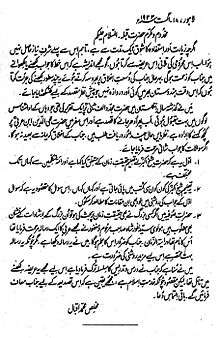Meher Ali Shah
| Meher Ali Shah | |
|---|---|
 | |
| Religion | Islam |
| Order | Sufism Qadiriya Chishti Order |
| Personal | |
| Born |
14 April 1859 (1 Ramadan 1275 A.H.) Golra Sharif, British India (Present Day Pakistan) |
| Died |
May 1937 (aged 78) Golra Sharif, British India (Present Day Pakistan) |
| Children | Syed Ghulam Mohiyyuddin Gilani |
| Parents | Syed Nazr Din Shah & Masuma Mawsufa |
| Senior posting | |
| Based in | Golra Sharif |
| Title | Pir |
| Predecessor | Sial Sharif |
| Successor | Syed Ghulam Mohiyyuddin Gilani |
Part of a series on Islam Sufism |
|---|
|
|
List of sufis |
|
|

Meher Ali Shah formally referred to as His Holiness, Huzoor Qibla e Aalam Tajdar-e-Golra Ala Hadrat Syedna Pir Meher Ali Shah sahib,(Urdu: پیر مہر على شاه) born 1 Ramadan 1275 A.H., i.e., 14 April 1859 in Golra Sharif, was a Sufi scholar from Pakistan belonging to the Chishti order. He is known as a Hanafi scholar leading the anti-Ahmadiyya movement. He wrote several books, most notably Saif e Chishtiyai ("The Sword of the Chishti Order"), a polemical work criticizing the Ahmadiyya movement of Mirza Ghulam Ahmad.[1][2]
Shah was a descendent, on his father Syed Nazr Din Shah's side, of Abdul Qadir Jilani in the 25th generation, and of Muhammad through Hassan Ibn-e-Ali in the 38th generation. On the side of his mother Masuma Mawsufa, he descended from Abdul Qadir Jilani in the 24th generation and from Muhammad through Hussain Ibn-e-Ali in the 37th generation.[3][4]
Education
He received his early Qur'anic education at the Khankah and was given classes in Urdu and Persian in the local Madressah.[5] After completing his education at Angah at the age of 15, he decided to continue further studies in the United Provinces (U.P) of India. He therefore set out for higher education in different parts of India including Kanpur, Aligarh, and Saharanpur. His stay at Aligarh at the madrasah of Lutfullah of Aligarh was for two and a half years.[6]
Works
- Tahqiq-ul-Haq Fi Kalima-tul-Haq (The Truth about Kalima-tul-Haq)[7]
- Shamsul Hidayah
- Saif-e-Chishtiya
- I’la Kalimatillah Fi Bayan-e-Wa Ma Uhilla Bihi Legharillah
- AlFatuhat-us-Samadiyyah (Divine Bounties)
- Tasfiah Mabain Sunni Wa Shi’ah
- Fatawa-e-Mehria
- Mulfuzaat-e-Mehria (Sayings of Meher Ali Shah)
- Fight against Ahmaddiya Movement
Sufi of the Chishti Order
Shah was a disciple and Khalifa of Khawaja Shams-ud-din Sialvi of Sial Sharif in the Silsila-e-Chishtia Nizamiyah.[8]

His biography, Meher-e-Muneer, records that he was also made a khalifa by Imdadullah Muhajir Makki, when he visited the latter in Mecca.

Supporter of Wahdat-ul-Wujood (The Unity of Existence)
Shah was a supporter of Ibn Arabi's ideology of Wahdat-ul-Wujood but he made a distinction between the creation and the creator (as did Ibn Arabi).[9] He also wrote explaining the "Unity of Being" doctrine of Ibn Arabi.
Like his comrade Qazi Mian Muhammad Amjad, he was an authority on Ibn Arabi and his 37-volume work The Meccan Illuminations (Al-Futūḥāt al-Makkiyya).
In 1933, Shah was absorbed in his meditation and mystic trances. That year the philosopher Muhammad Iqbal had to give a lecture at Cambridge University on Ibn Arabi's concept of Space and Time. He wrote a letter to the Shah stating that now there was nobody in all of Hindustan whom he could consult in this matter, and requesting him to tell about Ibn Arabi's work. In this letter Iqbal stated with respect that he knew he was disturbing the Shah's meditations, but as his motive was the service of Islam, therefore he dared to ask him a question. The Shah however, due to his meditation and bad health, could not reply.[10]

Death
In the early part of the month of Safar 1356-A.H (April 1937), he had an attack of cold, which soon developed into typhoid fever, which lasted for several days. His condition grew worse during the last days of Safar. On the morning of 29 Safar (11 May 1937), the pulse became irregular and the body temperature also underwent sudden changes.

Just before the arrival of the final irrevocable moment, he pronounced the words “Allah” from the deepest recesses of his heart in a manner which sent a shudder throughout his body from head to foot, and the reverberation of which was felt by every one who happened to touch the body. The next moment, he repeated the word “Allah” a second time and then turned his head towards the Qibla, thus signaling that the end had finally come.[11][12]
His three-day Urs is held every year from 27th to 29th Safar.
Honors
Pir Mehr Ali Shah Arid Agriculture University located at Murree Road Rawalpindi is named after him.[13]
Linked Scholars
- Syed Ghulam Moinuddin Gilani
- Naseer-uddin-Naseer
References
- ↑ Meher e Muneer. pp. 203–257.
- ↑ Mihr-e-munīr: Biography of Ḥaḍrat Syed Pīr Meher Alī Shāh ( in English).
- ↑ "Family and Ancestry". The Light of Golra Sharif.
- ↑ Mihr-e-munīr: Biography of Ḥaḍrat Syed Pīr Meher Alī Shāh ( in English). Golra Sharif.
- ↑ "Early Life and education". The Light of Golra Sharif.
- ↑ ul Haq Gilani, Ghulam Qutub. "Early life and Education". The Light of Golra Sharif.
- ↑ Tahqiq ul Haq Fi Kalimatil Haq. Maqtab Golra Sharif.
- ↑ www.thelightofgolrasharif.com Archived 11 February 2010 at the Wayback Machine.
- ↑ Mulfuzaat -e- Mehrya by Meher Ali Shah
- ↑ "Mehr Muneer" a Biography of Meher Ali shah by Maulana Faiz Ahmed
- ↑ "PASSING AWAY OF HAZRAT SYEDNA PIR MEHER ALI SHAH". The Light of Golra Sharif.
- ↑ Mihr-e-munīr. p. 296.
- ↑ "PMAS University".